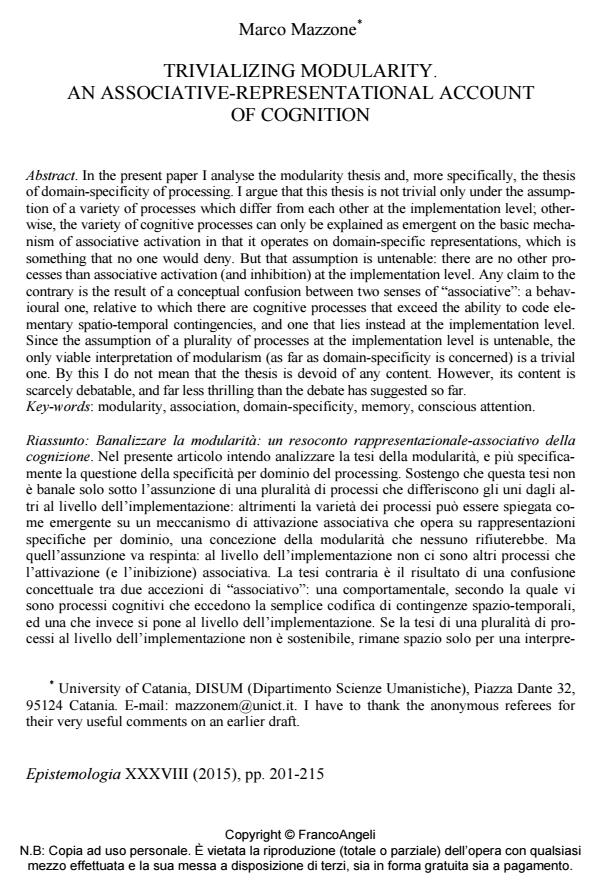Trivializing modularity. An associative-representational account of cognition
Titolo Rivista EPISTEMOLOGIA
Autori/Curatori Marco Mazzone
Anno di pubblicazione 2016 Fascicolo 2015/2
Lingua Inglese Numero pagine 15 P. 201-215 Dimensione file 166 KB
DOI 10.3280/EPIS2015-002003
Il DOI è il codice a barre della proprietà intellettuale: per saperne di più
clicca qui
Qui sotto puoi vedere in anteprima la prima pagina di questo articolo.
Se questo articolo ti interessa, lo puoi acquistare (e scaricare in formato pdf) seguendo le facili indicazioni per acquistare il download credit. Acquista Download Credits per scaricare questo Articolo in formato PDF

FrancoAngeli è membro della Publishers International Linking Association, Inc (PILA)associazione indipendente e non profit per facilitare (attraverso i servizi tecnologici implementati da CrossRef.org) l’accesso degli studiosi ai contenuti digitali nelle pubblicazioni professionali e scientifiche
In the present paper I analyse the modularity thesis and, more specifically, the thesis of domain-specificity of processing. I argue that this thesis is not trivial only under the assumption of a variety of processes which differ from each other at the implementation level; otherwise, the variety of cognitive processes can only be explained as emergent on the basic mechanism of associative activation in that it operates on domain-specific representations, which is something that no one would deny. But that assumption is untenable: there are no other processes than associative activation (and inhibition) at the implementation level. Any claim to the contrary is the result of a conceptual confusion between two senses of "associative": a behavioural one, relative to which there are cognitive processes that exceed the ability to code elementary spatio-temporal contingencies, and one that lies instead at the implementation level. Since the assumption of a plurality of processes at the implementation level is untenable, the only viable interpretation of modularism (as far as domain-specificity is concerned) is a trivial one. By this I do not mean that the thesis is devoid of any content. However, its content is scarcely debatable, and far less thrilling than the debate has suggested so far.
Nel presente articolo intendo analizzare la tesi della modularità, e più specificamente la questione della specificità per dominio del processing. Sostengo che questa tesi non è banale solo sotto l’assunzione di una pluralità di processi che differiscono gli uni dagli altri al livello dell’implementazione: altrimenti la varietà dei processi può essere spiegata come emergente su un meccanismo di attivazione associativa che opera su rappresentazioni specifiche per dominio, una concezione della modularità che nessuno rifiuterebbe. Ma quell’assunzione va respinta: al livello dell’implementazione non ci sono altri processi che l’attivazione (e l’inibizione) associativa. La tesi contraria è il risultato di una confusione concettuale tra due accezioni di "associativo": una comportamentale, secondo la quale vi sono processi cognitivi che eccedono la semplice codifica di contingenze spazio-temporali, ed una che invece si pone al livello dell’implementazione. Se la tesi di una pluralità di processi al livello dell’implementazione non è sostenibile, rimane spazio solo per una interpretazione banale della modularità (almeno per quanto concerne la specificità per dominio). Con questo non intendo che la tesi sia priva di contenuto. Essa è però ben poco discutibile, e meno eccitante di quanto sia apparso finora.
Parole chiave:Modularità, associazione, specificità per dominio, memoria, attenzione cosciente
Marco Mazzone, Trivializing modularity. An associative-representational account of cognition in "EPISTEMOLOGIA" 2/2015, pp 201-215, DOI: 10.3280/EPIS2015-002003